Then & Now: Baltimore Museum of Industry exhibit explores changing face of Charm City
Edmondson Village in west Baltimore circa 1948. Photo number 183988 from the BGE Collection.
Ask any graying Baltimore resident about their first haircut, and you will probably hear about the barber shop in Edmondson Village; the one with the monkeys in the window.
The Edmondson Village still exists, though both the whistling barber (G.L. Hardy) and the wacky monkeys are long gone. Fortunately, vintage pictures of places like The Village were discovered amongst a trove of workaday images amassed by the Baltimore Gas & Electric Company (BGE). This collection – which has been entrusted to the Baltimore Museum of Industry (BMI) – serves as the focal point of a fascinating new exhibit at the BMI, entitled Baltimore: Then & Now.
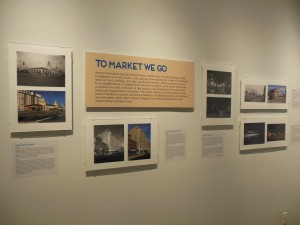
As the name suggests, Baltimore Then & Now pairs classic images of sites around the city with recent photos shot from approximately the same angle. All of the current photos were taken by area photographers as part of a contest sponsored by the BMI. The sixty image strong photo exhibit opened February 13 and will be in place til January 1, 2017.
Joseph Abel – Research Historian & Grant Writer at the BMI – told the Baltimore Post-Examiner the idea for this undertaking was born as one way to celebrate BGE’s 200th anniversary.
“As an historical resource, the BGE photos are really unmatched in our collection. There are some 80,000 pictures which go back as far as the late 1800’s.
“Being their anniversary, we wanted to figure out a way to feature that collection and showcase the history of Baltimore Gas & Electric. We’d had some success with a crowd sourced pop-up exhibit we did after the uprising last April. That’s when we came up with the idea of using the BGE images and then getting corresponding photos to juxtapose how much Baltimore has changed.”
Abel said BGE compiled the collection while chronicling the spread of the utilities services.

“The photos demonstrated how they were helping to change the face of the city while documenting jobs that they were doing. It was just their way of keeping records of their business. One of the issues we ran into as we were developing the exhibit was weeding through the less than sexy images. There are a whole lot of pictures of transformers and stuff like that; a lot of technical images.”
Jane D. Woltereck, Director of Collections for the Baltimore Museum of Industry, answered the question of how the BMI came to possess such a unique collection.
“I believe the BGE Collection was originally housed in the Peale Museum, which was then absorbed into the City Lights Museum. Once that entity closed, the collection passed to the Maryland Historical Society who then transferred it to us in the late 1990’s. We have a letter of agreement to be the repository of this wonderful collection.”
Abel added, “We have a long history with BGE. They have been supporters of our museum since its very beginning. It’s therefore a natural partnership for the company to deposit their records here. This is actually a soft opening for our museum’s re-do on the BGE permanent installation.”
The redesigned BGE installation opens March 31.
Images of a city in transition
Deciding which images to use was a monumental task. Ultimately, the BMI chose 50 shots as a baseline for the project, then whittled that number down to 33 images. The final result on display completes the arc of 30 iconic pictures.
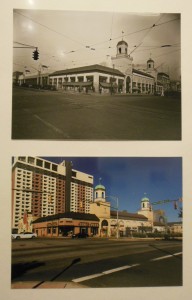
“Selecting the images,” explained Abel, “was a combination of finding visually compelling scenes which also tied some way into an historical setting. Some of them were more obvious, like the Bromo Seltzer Tower. But with others, we wanted to highlight lesser known historical stories. For example, the Mohawk Motor Inn. I have to acknowledge that I had my doubts about using that one. I mean – it’s a motel. But as it turns out, it was a motel in a part of town that has really been transformed by redevelopment.”
Abel said that aside from asking the photographers to take their pictures from roughly the same angle, the BMI was, “Counting on them to use their skills to create some really cool images”.
“One of our grand prize winners took the shot of Lexington Street where it intersects with Park Avenue. I think that night shot sadly captures what you can expect to find down there today.”
Did any of the “Today” shots surprise the curator?
“Oh, yeah!” said Abel, “especially in terms of some of the buildings which no longer exist. For instance – the National Casket Company. That location is now the site of both the Reginald F. Lewis Museum of Maryland African American History & Culture, and the Fairfield Inn. The original building burned down in the great fire of 1904, was rebuilt, and then torn down to make way for the Lewis Museum.
“Yet for every lost structure like the Casket Company, we have things like the North Avenue Market and Hecht/May Building which are still standing and have been repurposed. In some cases, you can see the trend of people moving back into the city. Hecht/May on Howard Street, for example, is now mostly apartments with the only business on the ground floor.

“One of the themes which I’ve seen through all of these images – for better and for worse – is the impact of the movement of people. Consider the picture of Fidelity Motors up on North Avenue. They used to call that area “automobile row” because that’s where all of the auto dealers were back in the early part of the 20th century. I find it ironic that that site is now a parking garage. As Baltimoreans took to the car, they began to move farther away from the city. The car dealers followed them into the suburbs, leaving behind neighborhoods which again were completely changed by the movement of people.”
There is indeed a certain sadness to many of the photos in the exhibit, as one can envision a business-rich Baltimore that no longer exists. But Abel said he and his colleagues trust that patrons will also appreciate the thread which runs through a number of the modern shots – the encouraging sense of a city on the rebound.
“We’re really happy with the way the project turned out. I think there’s a nostalgia factor here, but you couple them with what’s going on now – it makes the images relevant to people. It’s more than just, ‘Oh wow, look at what that site looked like back then’. It’s about what it’s become. What we as Baltimoreans have become.
“It’s been so easy in the last year for people to be down on Baltimore,” concluded Abel. “I believe that this exhibition emphasizes that there’s a lot of good happening in this city. The Baltimore of the 1940’s doesn’t exist anymore. But other businesses, other industry is popping up in its place. That’s reflected in these images.
“At least, I certainly hope it is.”
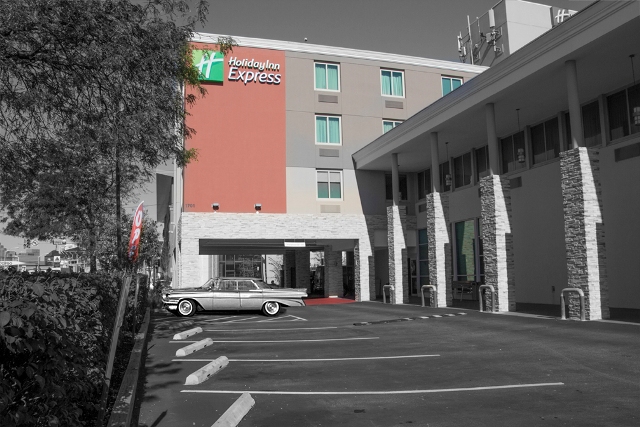
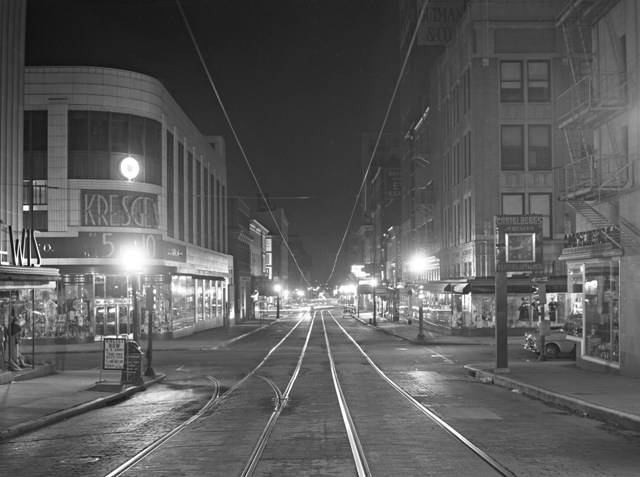

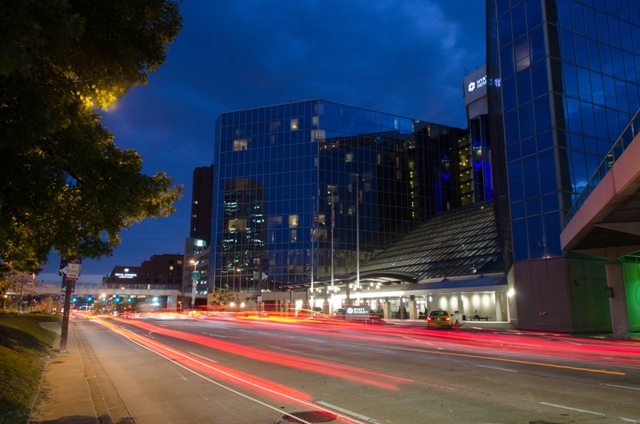
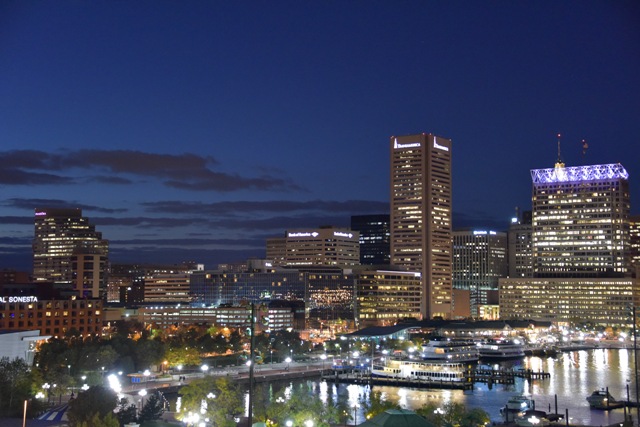

Anthony C. Hayes is an actor, author, raconteur, rapscallion and bon vivant. A one-time newsboy for the Evening Sun and professional presence at the Washington Herald, Tony’s poetry, photography, humor, and prose have also been featured in Smile, Hon, You’re in Baltimore!, Destination Maryland, Magic Octopus Magazine, Los Angeles Post-Examiner, Voice of Baltimore, SmartCEO, Alvarez Fiction, and Tales of Blood and Roses. If you notice that his work has been purloined, please let him know. As the Good Book says, “Thou shalt not steal.”
